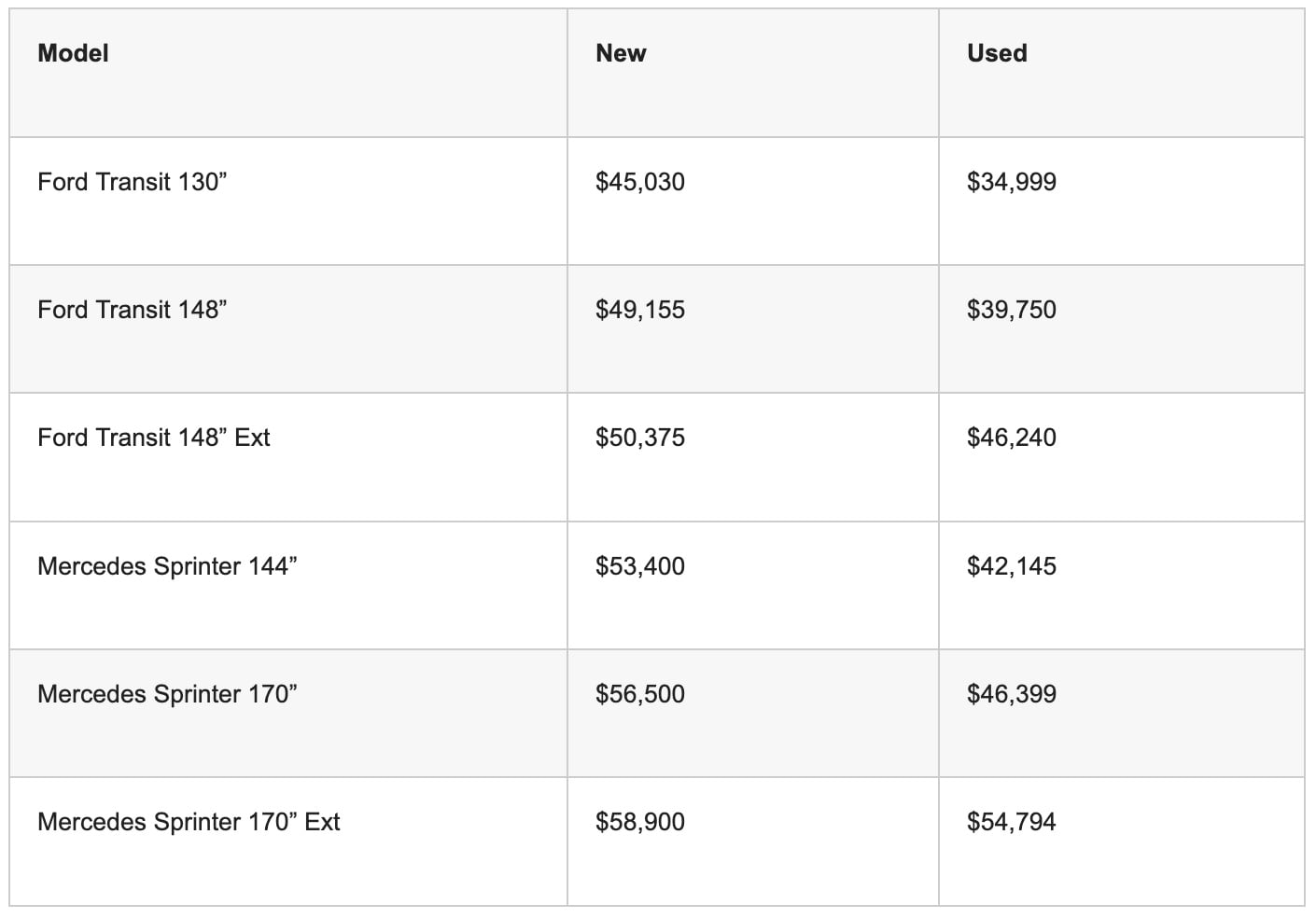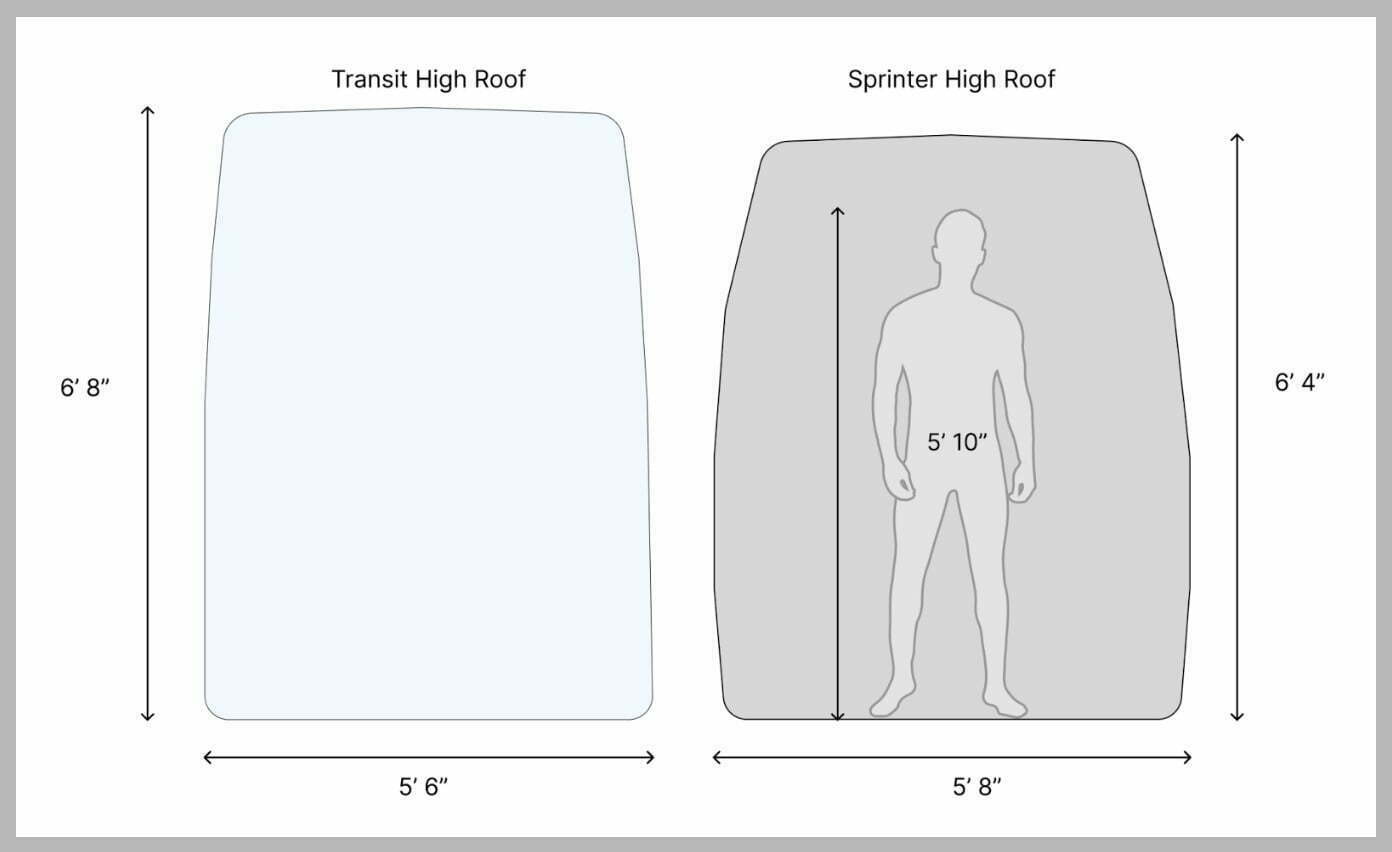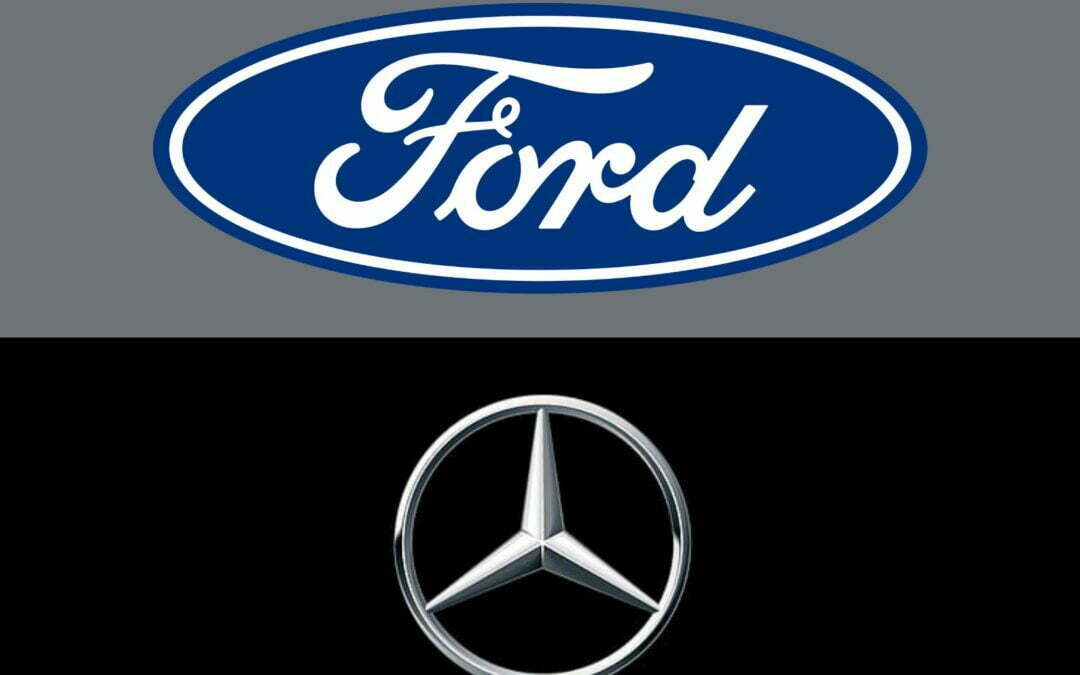The Sprinter is reliable, cool looking, and features optional 4×4, while the Transit is cheaper, easier to service, and considered by many to be more comfortable to drive.
But there has to be a clear winner, right?
In this article, we’ve answered four important questions to help you decide.
Comparing The Sprinter Van and Ford Transit
Which van is better to own?
When considering the ownership of each van, several factors stand out beyond the general driving experience.
Maintenance
Maintenance is no one’s favorite subject, but it’s important to consider when calculating the cost of owning a vehicle. The Sprinter and Transit require similar maintenance, but Mercedes and Ford charge very different prices.
As mentioned in our Sprinter vs Transit vs ProMaster article, the estimated maintenance cost differences between both vans when accounting for the lifetime ownership of each differ by between $6,400 and $10,000.
Reliability
The Sprinter and Transit are both modern, reliable vehicles, but the Sprinter, with its ultra-reliable diesel engine, is likely to outlast the Transit. Sprinters can see 300,000+ miles when properly maintained, while Transits often reach over 200,000+.
No vehicle is without problems, however, so here are a few reliability issues to be aware of:
Sprinter Reliability Issues:
- Def Problems: It’s not uncommon for people to experience problems with the DEF (diesel exhaust fluid) system on the Mercedes Sprinter van, such as DEF pump failures, DEF sensor malfunctions, or DEF system contamination, leading to warning lights, reduced engine power, and emission-related issues.
- Glow Plug Issues: Another common issue Sprinter van owners experience are issues with the glow plugs, resulting in difficulties with cold-starting the engine, prolonged cranking times, and potential engine misfires.
- Clogged DPF filter: Clogged DPF (Diesel Particulate Filter) filters are a common issue in the Mercedes Sprinter van, causing reduced engine power, increased fuel consumption, and potential warning lights due to restricted exhaust flow and the accumulation of soot and particulate matter.
- Torque converter: Issues with the torque converter in the Mercedes Sprinter van can lead to transmission slipping, overheating, delayed or harsh shifting, and reduced overall performance.
- Injector Issues: Injector issues in the Mercedes Sprinter van can result in fuel delivery problems, leading to rough engine performance, reduced power, potential engine misfires, and the need for inspection and repair.
*Def issues are most prevalent in 2010-2016 Sprinter vans. DEF systems were relatively new at the time so many manufacturers had issues.
Transit Reliability Issues:
- Water Leak Issue: A prominent water leak caused by a poor windshield design has caused a lot of issues with water penetrating the cab of the Transit van.
- Throttle Body: The throttle body on earlier Ford Transit vans prematurely wears out, leading to rough idling, poor acceleration, and reduced engine performance and economy.
- U-Joint: Earlier versions of the Transit van featuring a Guibo coupling were recalled because of premature wear that caused vibration.
Resale Value
When planning a van conversion, it’s important to consider resale value because van lifers often sell their vans after a few years of travel, either to upgrade or to settle down.
When comparing the resale value of the Sprinter and Transit, the Sprinter stands out as the better choice. Despite having a higher initial cost, the Sprinter remains more valuable on average because of its strong reputation and reliable diesel engine. The Transit also has good resale value but declines more rapidly after 100,000 miles of use.
Here’s a cost comparison of each van:

Which Van Is Better To Drive?
The Transit and Sprinter are both comfortable, but the Transit has a slight edge, primarily because, as many people who have test-driven both vans say, the Transit feels more “car-like.”
The Transit’s car-like feeling is partly thanks to its 3.5-liter EcoBoost V6 engine, which it shares with the Ford Raptor. Although detuned, the Transits EcoBoost engine delivers over 300 horsepower and 400 lb-ft of torque. This power plant provides the Transit with surprising quickness off the line, making it feel smaller and lighter than it is.
In addition to its engine, the Transit shares many components with other Ford vehicles, which provide a sense of familiarity and comfort to Ford owners.
The Sprinter is by no means uncomfortable; its driver’s cabin feels more luxurious than the Transit, and its torquey diesel engine provides plenty of power for hauling heavy builds.
Which Van Is Better To Live In?
Daily life experience in a van is shaped more by the build than the minor differences between particular vehicles. Still, there are differences to consider when choosing between the Transit and Sprinter.
Available Space
Space is, of course, one of the most important variables to consider. Mercedes and Ford offer short, medium, and long wheelbases, varying in length from 10 to 15 feet. When choosing between the vans, both manufacturer’s wheelbases can suit smaller builds that prioritize maneuverability and longer builds that maximum living space. Where the differences start to stand out is in the headroom and width.
The Transit’s 6′ 8″ ceiling height, available on the high-roof model, provides an additional 4 inches of headroom over the high-roof Sprinter. This extra head space feels much more spacious, especially for individuals over 6 feet tall. If you’re not over 6 foot, the Sprinter offers plenty of headroom and can suit accessories like air conditioners and Maxxair fans.
The width of both vans differs by only 2 inches at the floor, with the Sprinter being slightly wider, but the Transit often feels wider, because its less curved toward the top of the van.
If your build plans feature a lot of overhead cabinetry, the Transit may be a better bet, whereas the Sprinter can feel more spacious side to side if your furniture sits low to the ground.
Step Height
The entry door step height is an often overlooked aspect of living in a van. For shorter individuals, this can be an annoying obstacle when cooking outside and doing other activities that repeatedly have you in and out of the vehicle. The Sprinter is surprisingly tall, which offers excellent ground clearance for off-road driving but also raises the entry height of the van to roughly 20 inches, about 4 inches more than the Transit.
Which Van Is Better To Build?
When considering the build-ability of each van, three factors stand out:
The Shape
The Sprinter has notoriously curvy walls, which make adapting square objects like cabinetry, paneling, and other rectangular objects difficult. If you have experience with carpentry, this is less of an issue, but it is worth noting that many DIY’ers have frustrations about this challenge. The Transit is by no means a square box, but it is less curved.

Online Help
When it comes to online information, the Sprinter is king. The Transit is growing in popularity, but there is still nowhere near as much information available online as there is for the Sprinter van—just something to consider.
Aftermarket Parts
One of the main advantages of customizing a popular van like the Sprinter is the availability of aftermarket parts. When comparing the availability of parts for the Sprinter and Transit, the Sprinter has a clear advantage. Companies like Aluminess, Backwoods Adventure Mods, Fab Fours, Fiamma, & RB Components, provide dozens of high-end aftermarket parts that make customizing a Sprinter more accessible.
So, Which Van Should You Choose? The Mercedes Sprinter Van or the Ford Transit Van?
The first and most important step to take when deciding between the Sprinter and Ford Transit is to test drive. You can test drive both vehicles relatively easily by visiting a dealership or by using a campervan rental service. Experiencing both vehicles firsthand will do more to help you decide than anything.
To wrap up, here are a few additional questions to consider:
- How much do you care about fuel economy? The Sprinter gets a few MPG better than the Transit (18 MPG combined vs 15 MPG), which can add up over tens of thousands of miles.
- How much do you care about going off-road? The Sprinter is the only true 4×4 option available for these two vehicles, which offers advantages over AWD. Unfortunately, the newest Sprinter van is not available with 4×4, only AWD like the Transit. So if you want 4×4, you’ll need to buy used.
- How much do you care about maintenance cost? Over 200,000 miles, the estimated service cost for the Sprinter is $8,900-$14,200 compared to $2,500-$3,250 for the Transit.
- How much do you care about the vehicle cost? The Transit and Sprinter vary in price by roughly $5,000-$10,000, depending on the model and configuration. Both vehicles have excellent resale value, but the Sprinter van is better because of its expected longevity.
Conclusion
In conclusion, you really can’t go wrong with either van. The Sprinter is just plain cool, and is very reliable. While the Transit is less expensive and equally as capable. To decide, test drive both vehicles. If you prefer the feel of the Sprinter and you’re okay with the added costs, go with it. Otherwise, the Transit is a great option.
Written by Taran Causey

